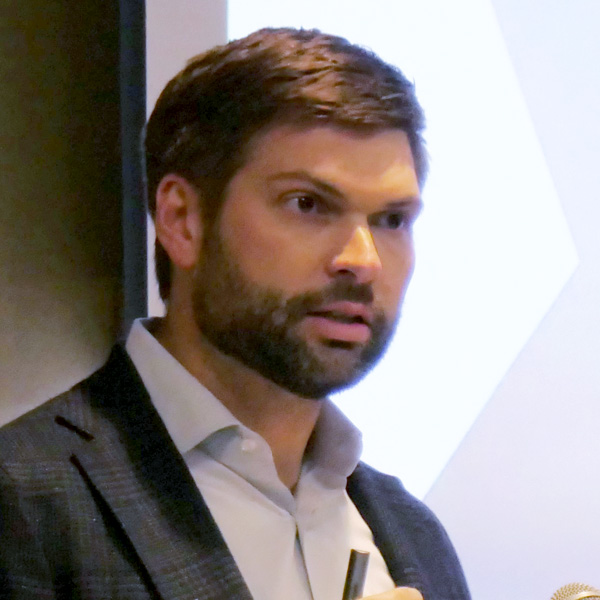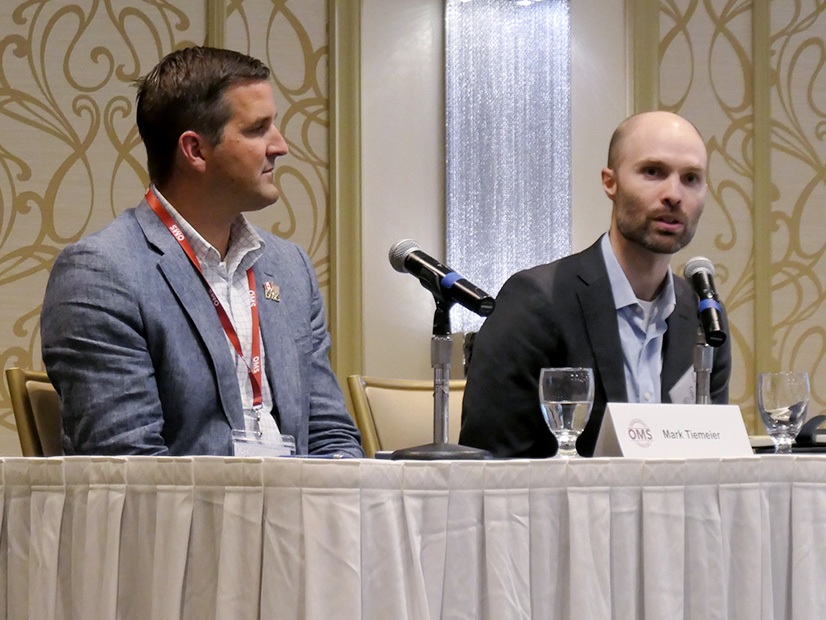State regulators, MISO and members remain anxious over the fragile state of resource adequacy, how much load growth to expect and a potential new resource adequacy standard.
MADISON, Wis. — State regulators, MISO and members remain anxious over the fragile state of resource adequacy, how much load growth to expect and what a potential new resource adequacy standard might look like.
Regulators and stakeholders descended on Madison, Wis., to talk about the issues at the Organization of MISO States’ annual meeting Oct. 23-24.
Load Growth: Swift! Shocking! Legitimate?
Electric Power Research Institute’s David Larson said data center growth mapping efforts quickly become outdated as requests for interconnection routinely exceed expectations in number and size.
He said the “AI race has now become a powering-AI race.”
“There is a question of: ‘How much of this is real?’” Larson said. He said utilities sometimes treat requests as not definite until construction begins, while some assume only a percentage is likely.
Mike Benn, with data center developer STACK, said “availability and certainty of power” is top of mind for companies that require newly built data centers. He said that though load growth numbers are big and real, some speculators are calling utilities to inquire about available capacity or those in a race to try to hoard capacity.
Benn said it’s important that data centers be part of the solution in securing energy.
“It might be very cathartic to call up the utility and yell, ‘You promised you had this capacity to serve us, now you don’t!’ That helps no one,” Benn said.
“Has anybody checked their email by phone or computer? If so, you’ve used a data center,” Google’s Tyler Huebner asked.
Huebner said individual companies for the most part have abandoned their backroom servers and have migrated services to data centers. The eradication of the small server rooms to large data centers is more efficient and ultimately saves more water and power, he said.
Huebner said Google strives to forge partnerships with utilities and companies to become a market force for sustainable energy, backing geothermal projects, storage and small nuclear reactors, sometimes above market prices.
“We’re willing to bring financial commitments and collateral to the table,” he said.
However, Huebner said while Google doesn’t want to raise customer prices, it also doesn’t want to entirely fund projects it no longer has use for, especially when those projects’ output gets claimed by other industries.
Huebner said it used to be a matter of securing real estate and then figuring out the rest to site a data center.
“Now it’s power and nothing else,” he said.
NextEra Energy’s Erin Murphy said NextEra is approaching MISO, looking for ways to link proposed generation resources and their designated loads in MISO’s generation interconnection study process to meet the needs of industrial customers.
Murphy said with the MISO queue’s current five-year wait times, a MISO fast-track for resources with contractual agreements to serve load would be helpful.
Larson said some hyperscale loads might be flexible but that EPRI encounters challenges getting data centers to publicly share demand response capabilities for analysis.
“Data access is a huge bottleneck for us. We’ll have folks that say, ‘Trust us, it’s a flat load,’” he said.
Huebner said Google is working with peers on demand response and said the company does have a “vested interest” in MISO’s recent proposal to reduce capacity credits for its load-modifying resources. (See MISO Tries to Win over Stakeholders on New LMR Capacity Accreditation.)
‘Angsty’ Times
Ryan Long, Xcel Energy president of Minnesota and the Dakotas, said much of the “angst” associated with the energy transition today boils down to the industry “living between” major eras.
“We’re in the seam between power-sector decarbonization and economy-wide decarbonization. … We’re trying to find our way through the energy transition and bring along other industries,” he told attendees.
Long said when Xcel Energy’s Northern States Power retires its Allen S. King and Sherco coal plants by 2030, it will lose 3 GW of its 9 GW portfolio.
“That means we’re going to lose a third of generating on our system. And we have a whole lot of work to do and construction to do,” he said.
Long said Xcel doesn’t assume it will rely on the MISO market to serve load in future-looking analyses. He said the move is somewhat controversial, but he believes load-serving entities should build generation to meet their native loads and use the market only to optimize financial outcomes and earn economic hedging.
Long said the rise of data center load can be considered the “first ship in the port,” with manufacturing and transportation growth to follow as the energy industry further decarbonizes and adds firm resources.
Long said ratepayers can benefit if utilities carefully structure agreements with large customers. He said large customers can help steer a swifter transition, and he predicted hyperscale customers will drive the advancement of small modular reactors.
“We’re running out of nuclear plants that are sitting around that could be brought back online,” he joked, and later said: “There is a real need to think about how we can all move faster.”
That’s led Xcel to turn to an iron-air, “rusting and unrusting” battery facility in Becker, Minn., through a partnership with Form Energy; a solar farm at the Sherco site; and extending the lives of its two nuclear plants beyond 2050, Long said. He added that Xcel is betting on battery storage by planning to build an additional 600 MW in addition to the iron-air battery facility.
He also said Xcel proposes to add anywhere from 400 MW to 1 GW of distributed resources at strategic locations.
“At the distribution level, you can add resources fairly quickly, and it feels like the moment certainly calls for an all options on the table strategy,” Long said.
RA Targets on the Move
MISO Executive Director of Markets and Grid Research DL Oates said given the zeitgeist, MISO’s role in providing supply and demand outlooks becomes more critical. He pointed to MISO and OMS’s annual resource adequacy survey and its regional resource assessment as increasingly important reference points for construction plans.
Oates said because the environment is so uncertain, publishing a range of possible outcomes from scenario-based modeling is appropriate. He said he realizes utilities are building long-lived assets, and a planned facility sometimes can be found to help under several possibilities.
Oates also said because risks are growing more complex, MISO needs a more complex reflection of resource adequacy, expressed (ER24-1638). (See related story, FERC Approves New MISO Probabilistic Capacity Accreditation.) Oates said MISO understands it needs to conduct analyses to predict how its proposed resource accreditations for resource classes are likely to change over time based on how much they can help.
Midwest Reliability Organization’s Mark Tiemeier said across NERC, EPRI and ESIG, there’s consensus that the one-day-in-10-years loss-of-load standard is passé when used alone.
“To me, it’s a very binary answer,” he said, though he added that he didn’t think grid operators would scrap it entirely.
Tiemeier said with the past no longer an indicator of what’s to come with reliability, grid operators need to turn more toward a least-regrets standard that combines multiple elements.
He also said MRO has asked for more consistency across the data regions to provide NERC for its reliability assessments. He said more data consistency would lead to more accurate comparisons between regions.
Oates agreed MISO likely needs multiple metrics beyond its one-day-in-10-years standard to measure adequacy. (See MISO Dips Toes into Potential New Resource Adequacy Standard; States Demand Key Role.) MISO has said it might consider a combination of conditional value at risk, loss-of-load hours and expected unserved energy in addition to the one-day-in-10-years criterion.
Oates said while multiple grid operators explore adopting new modes of resource adequacy measurements, they’re not all examining the same methods, creating the possibility that RA standards will become even less homogenous.
“When you look at where to move to, there’s a lot of heterogeneity there. And I think that’s a hallmark of living in a time of change,” he said.
“I think if there’s anything that be taken from this, it’s complicated,” joked Wisconsin Commissioner Marcus Hawkins.
Signifying how often RA issues have come to the fore, OMS members passed a motion to create a resource adequacy committee.
Former State Regulator Says Commissions Need More Hands, Data Analysis, Openness
Known for his frankness, Kent Chandler, former Kentucky Public Service Commissioner and a new addition to center-right think tank R Street, was invited to speak on how commissions should equip themselves as resource adequacy concerns and load growth take firmer hold in the footprint.
Chandler encouraged commission staff to “shoot for the stars” with their budget asks and correct understaffing now. He advised commissioners to double the level of resources they think they can operate with.
Chandler said commissions suffer from getting “asymmetrical” data from utilities. He said at the Kentucky commission, just one staff member usually would review data submittals from utilities for completeness.
Chandler also said commissions are privy to substantially more information from vertically integrated utilities in RTOs versus vertically integrated utilities that aren’t in RTOs.
“I couldn’t tell you where any congestion is on the [Louisville Gas & Electric and Kentucky Utilities] system,” he said as an example.
Chandler told commissioners and staff to “hold your utilities to account” based on the data they can retrieve. He told them to ask utilities what they’re doing about resource planning, why they’re making certain offers in the wholesale market, or why they’re not addressing congestion “that shows up five days a week.”
Commissions also are “woefully” short on distribution system expertise, Chandler said.
“Very few people who I’ve ever interacted with know how the distribution system works,” he said.
Chandler said it’s important to recruit people with distribution system knowledge as distributed resources — demand response, batteries, generation — will play a more integral role in resource adequacy, like it or not.
Chandler also said while he wouldn’t say MISO has it right on resource accreditation, it’s moving in the right direction by measuring capacity contributions when resource adequacy is the frailest.
“I think it gives owners an incentive to make sure their generation is best in class,” he said, adding that MISO could add a layer to its accreditation where it shows locally what type of generation would be most helpful.
“This is my Festivus. It’s my airing of the grievances. It’s professional; it’s not personal,” he joked.
Finally, Chandler said it might be worthwhile for OMS to set up private meetings between its board and the MISO Board of Directors to discuss major initiatives to be filed at FERC. He said the MISO board should want to know how its regulators fall on MISO’s proposals.
In closing, Chandler told regulators to be willing to admit when their processes aren’t working and work to improve them. He also told regulators to not be afraid to hear opposition, and said he never understood denying interventions in dockets. Chandler said though he’s not a “Kumbaya-type of person,” there’s value in interacting with people who disagree with you.
“Everybody thinks their baby is the cutest. It’s almost never true. There can only be one cutest baby. There’s always a way to do things better. … You can make your baby cuter,” Chandler said.







